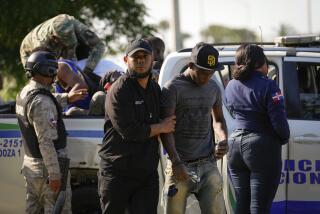Broke Dominican Republic Spends Freely to Spruce Up for Columbus Celebration : Caribbean: The president’s building spree results in a gleaming new airport, public housing projects, schools, paved roads, dams and assorted monuments.
- Share via
SANTO DOMINGO, Dominican Republic — The oldest city in the Americas has spent a fortune sprucing itself up 500 years after Columbus landed on its shores, and not everyone thinks it was a good idea.
President Joaquin Balaguer’s $2-billion building spree, begun in 1988, has produced a gleaming new airport, pastel public housing projects, schools, paved roads, dams and assorted monuments.
“It looks like a new country, doesn’t it?” said Juan Jose Arteaga, the government economics adviser.
Private economists and some politicians say the unprecedented renovation cannot conceal reality in this impoverished, indebted country of 7 million people. They say most of the projects were financed by printing money.
The government predicts that throngs of tourists will come in 1992, more than paying the bill. The visitors, Pope John Paul II among them, will see new apartment houses in place of many of the shantytowns that once ringed this bustling capital of 2.2 million people.
Remains that the Dominicans believe to be those of Columbus will be moved from the Santo Domingo Cathedral to the Columbus Memorial Lighthouse, which is 150 feet high and cost $50 million. The lighthouse will light the sky above the oldest city in the Americas with a laser in the shape of a cross.
According to his critics, Balaguer’s building program caused the current recession, which resulted in a 5% decline in the economy last year. The Dominican Republic has a foreign debt of $4.5 billion, and 28% of workers are unemployed.
“It will take many years and many millions of dollars to fix this country,” said Miguel Ceara Hatton, director of the Center of Economic Investigation.
The critics also say the government has neglected agriculture, public education and health.
Labor unions have held nationwide general strikes to press for wage increases and protest austerity measures designed to satisfy International Monetary Fund conditions for credit. In July, at least three people were killed, dozens wounded and several hundred arrested in clashes between strikers and police.
About 15,000 doctors, nurses and lab technicians in public hospitals began the longest strike in Dominican history in April. Their monthly pay ranges from $100 to $200.
Hospitals operate at less than half staff capacity, with military doctors filling in.
At Our Lady of High Grace maternity hospital, women who have just given birth occupy beds cushioned with strips of cardboard instead of mattresses. One newborn, unsupervised in an incubator, was covered with a blood-soaked blanket.
In May, 36,000 teachers walked out of public elementary and high schools, contending that their salaries of $80 a month barely cover transportation. The Dominican Teachers’ Assn. says 90% of the nearly 3 million schools lack water and many don’t have toilets.
The strikes capped a year of unrest marked by protests, price increases and shortages of food and gasoline. Inflation was a record 100%.
Things may be getting better.
Balaguer’s government stopped printing unbacked currency last year in an attempt to halt the decline, and there has been virtually no inflation since January.
“The economy is better than it was in December, but we have a recession,” said economist Ceara Hatton, the private economist.
Subsidies on basic foods and gasoline were ended at the insistence of the International Monetary Fund. The Dominican Republic has been behind on its foreign debt since 1988 and desperately needs IMF approval for new loans.
More to Read
Sign up for Essential California
The most important California stories and recommendations in your inbox every morning.
You may occasionally receive promotional content from the Los Angeles Times.













